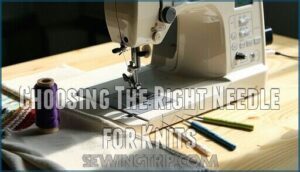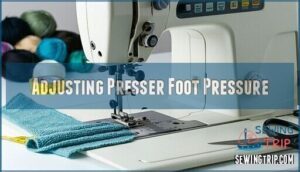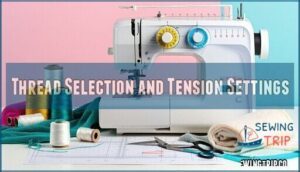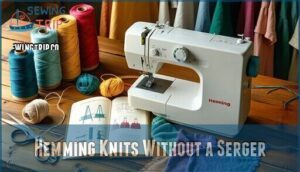This site is supported by our readers. We may earn a commission, at no cost to you, if you purchase through links.

Here’s the truth: sergers are convenient, but they’re not essential. Your standard sewing machine can manage knits beautifully when you understand a few key adjustments. The secret lies in matching your needle, stitch, and settings to the fabric’s stretch—not in owning specialized equipment.
With the right techniques, you’ll create seams that move with the fabric and hems that look professionally finished, all without spending hundreds on a serger.
Table Of Contents
Key Takeaways
- You can sew knits successfully on a regular machine by using ballpoint or stretch needles, adjusting presser foot pressure, and selecting stitches like zigzag or twin needle that accommodate fabric stretch—no serger required.
- Proper tension settings, longer stitch lengths (2.5-3mm), and polyester thread prevent seams from snapping while allowing knit fabrics to move naturally without puckering or distortion.
- Supporting fabric weight during sewing, testing settings on scraps first, and using accessories like walking feet or fabric stabilizers keep stretchy materials under control and prevent warping.
- Professional-looking hems and seam finishes are achievable through techniques like twin needle topstitching, narrow zigzag stitches, and steam pressing—delivering store-quality results with standard equipment.
How to Sew Knits on a Regular Machine
You don’t need a serger to work with knits—your regular sewing machine can manage them beautifully with the right setup. A few key adjustments to your machine will make all the difference in how your stretchy fabrics behave.
Let’s walk through the essentials that’ll set you up for success.
Choosing The Right Needle for Knits
Your needle choice makes or breaks knit projects. Switch to a ballpoint needle, jersey needle, or stretch needle—each has a rounded tip that glides between fabric fibers instead of piercing them. This simple swap prevents snags, skipped stitches, and those frustrating holes that ruin stretch fabric.
Match your needle size to your knit fabric weight, and you’ll see immediate improvements in stitch quality and thread tension. For best results, understanding the right needle types is essential for working with various knit fabrics.
Adjusting Presser Foot Pressure
Once you’ve got the right needle in place, your presser foot pressure needs a quick adjustment to keep knit fabric from stretching out of shape as it feeds through the machine. Reduce your pressure control setting—lighter foot adjustment prevents the fabric from getting squashed and distorted.
Test your tension settings on scraps first. This stitch regulation tweak gives you better fabric guidance when sewing knits without a serger, letting stretch fabrics glide smoothly without waves or puckers.
Thread Selection and Tension Settings
Your thread choice and tension dial work together like a good partnership—get one wrong, and even perfect stitches start to fall apart.
Here’s what you need:
- Polyester thread moves with fabric stretch better than cotton
- Lower needle tension prevents seams from snapping when pulled
- Slightly longer stitch length (2.5–3mm) accommodates knit movement
- Test on scraps before committing to your project
- Adjust tension control gradually—small tweaks make big differences
These sewing machine settings transform how you manage stretch stitches and sewing knits without a serger.
Sewing Machine Accessories for Knits
The right accessories can turn a stubborn knit fabric into an easy win—no wrestling required. A walking foot grabs both layers evenly so they don’t shift. Ballpoint needles slide between fibers instead of piercing them, and a twin needle gives you that professional-looking double topstitch with built-in stretch.
| Sewing Machine Accessories | Why You Need It |
|---|---|
| Walking Foot | Keeps fabric layers feeding evenly without distortion |
| Ballpoint Needles | Prevents snags and skipped stitches on knit fabrics |
| Twin Needle | Creates stretchy hems with a professional finish |
| Stretch Guides | Helps maintain consistent seam allowances |
| Fabric Stabilizers | Prevents necklines and shoulders from stretching out |
Pair these with proper sewing machine settings—like zigzag stitch and adjusted tension gauges—and you’ll manage interfacing tools and knit feed dogs like you’ve been doing it for years.
Best Stitch Techniques for Knit Fabrics
The right stitch makes all the difference when you’re working with stretchy fabrics. Your regular sewing machine has several built-in stitches that can manage knits beautifully without needing a serger.
Let’s look at the best stitch options that’ll keep your seams strong and flexible.
Zigzag Stitch for Stretch Seams
When you need seam stretch control that moves with your fabric, the zigzag stitch is your workhorse for sewing knits without a serger. Set your width between 2.5 and 3.5 mm and length around 2 to 2.5 mm—these zigzag settings allow up to 40% stretch while a straight stitch barely budges at 5%. Pair it with a stretch needle and check your stitch tension on scraps first.
This setup gives you fabric recovery and elastic attachment that withstands wear, whether you’re tackling jersey tees or activewear seams on knit fabric. For more information on choosing the right stitch, consider the sewing machine stitches suitable for your project.
Faux Overlock and Overcast Stitches
Want to mimic a serger’s clean finish without actually owning one? Your machine’s faux overlock stitch or overcast stitch gives you professional seam finishing on stretch seams.
These built-in overlock stitches wrap thread around raw edges like fabric binding, preventing fraying while maintaining stretch.
Test your overlock method on scraps—adjust width for coverage and pair with a stretch needle when sewing knits without a serger.
Reinforced Straight Stitch Methods
Sometimes a straight stitch is all you need—but only if you know how to reinforce it so it won’t snap under pressure. When sewing knits without a serger, try sewing two parallel straight stitches about 1/8" apart for seam reinforcements that hold up to stretch.
You can also add fabric stabilizers or interfacing methods along stress points—think shoulders or necklines—to prevent popping threads while preserving your knit fabric’s natural give.
Using a Twin Needle for Hems
If you want hems that look store-bought and stretch like a dream, a twin needle is your secret weapon. This hemming technique uses two needles threaded through a single bobbin, creating parallel topstitching that flexes with your knit fabric.
Choose a ballpoint twin needle for sewing knit fabrics—usually 2.5mm or 4mm width works best. Test your stitch lengths on scraps first, and keep fabric selection in mind: lighter knits need finer needles.
Hemming knit garments without a serger just got easier.
Hemming Knits Without a Serger
Hemming knit fabrics doesn’t require fancy equipment—just a few smart techniques that work with your regular machine. You can create clean, stretchy hems that won’t pop or pucker when you pull on the finished garment.
Here are three reliable methods to get professional results every time.
Single Fold and Double Fold Hemming
Hemming knits comes down to two simple methods—single fold and double fold—and knowing when to use each one can make or break your finished garment.
A single fold works beautifully on lightweight knits where bulk is your enemy, while double fold hemming techniques add stability to heavier fabrics.
Keep your seam allowance consistent, and you’ll nail hem stability without a serger every time.
Narrow Zigzag Hem for Stretch
The narrow zigzag stitch is your secret weapon for hems that stretch, bounce back, and never pop a single thread. Here’s how to master this technique for sewing knit fabrics without a serger:
- Set your stitch width to 1-1.5mm for fabric stretch control
- Adjust length to 2-2.5mm for sewing elastic seams that hold
- Test on scrap fabric first—hemming knit edges requires practice
- Keep tension balanced to prevent puckering along the narrow zigzag
This zigzag stitch guide ensures your stretch hem tips deliver professional results every time you’re sewing without a serger.
Creating a Professional Twin Needle Hem
Twin needles take your knit hems from "homemade" to "store-bought" with one simple swap—two parallel rows of topstitching that stretch without snapping. Thread both spools through your machine, select a narrow zigzag underneath for flexibility, and test your needle tension on scrap fabric.
When sewing knit fabrics, this hemming technique delivers reinforced straight stitch strength with built-in stretch—no serger required.
Tips for Handling and Sewing Stretchy Fabrics
Knit fabrics have a mind of their own, and knowing how to manage them makes all the difference. A few simple techniques will keep your stretchy material under control from start to finish.
Here’s what you need to focus on to prevent mishaps and get clean, professional results.
Using Ballpoint Pins and Needles
Ballpoint pins are your best defense against accidentally punching holes in delicate knit fibers while you cut and pin your fabric. Regular pins have sharp tips that can snag jersey or stretch materials, but ballpoint tips gently slide between threads instead of piercing them.
Pair them with ballpoint needles or a jersey needle for sewing knit fabric, and you’ll maintain fabric grip and stretch control without damaging your material—no serger required.
Supporting Fabric Weight During Sewing
Letting knit fabric drape freely off your work surface is like asking for trouble—the weight pulls and stretches seams as you sew, warping everything you’ve pinned in place.
Keep your fabric supported by bunching the bulk in your lap or on a nearby table so gravity doesn’t fight your tension control and fabric grainline.
This simple fabric management trick gives you sewing stability and helps with seam reinforcement, especially when you’re working with heavy jersey or preparing fabric for clean seam finishing methods.
Preventing Fabric Stretch and Distortion
Beyond supporting fabric weight, you need to manage foot pressure and manipulation techniques to keep knits from warping out of shape. Lower your presser foot pressure for soft jersey knit fabrics—heavy pressure drags and distorts seams while you’re sewing without a serger. A walking foot feeds both layers evenly, protecting fabric grainline and stretchability.
- Gently guide fabric through—never pull or resist the feed
- Test your stitch types on scraps to check fabric recovery
- Use ballpoint pins to protect knit fabric characteristics
- Steam stretched seams afterward to restore their shape
- Choose stable knits when you’re just learning these manipulation techniques
Troubleshooting and Finishing Knit Projects
You’ve mastered the basics—now it’s time to polish your work. Even with the right stitches and techniques, knit projects can hit a few snags before they’re ready to wear.
Here’s how to troubleshoot common issues and give your seams that professional finish.
Avoiding Puckering and Wavy Seams
Puckering happens when tension gets out of balance. To address this, lower your pressure foot by 20–40% and slow down to under 450 stitches per minute—this combo cuts distortion drastically.
Switch to a stretch needle in 70/10 or 80/12, lengthen your stitch to 2.5–3.0 mm, and use stabilizers like tape or tissue paper for added support.
Steam pressing after sewing flattens wavy seams beautifully.
Seam Finishing Options Without a Serger
You don’t need a serger to lock down your seams—a regular machine manages it beautifully with the right approach. Try a zigzag stitch or overlock stitch to seal raw edges and prevent fraying.
For extra hold, add seam binding or use folded seams pressed flat.
Knit stabilizers and fabric interfacing work wonders when edges need reinforcement, giving your hemming techniques and edge finishing that polished, professional look.
Pressing Seams for a Polished Look
A hot iron transforms wobbly seams into crisp, flat lines that look straight off a retail rack. Steam helps with fabric relaxation, letting knits settle without puckering.
Here’s how to nail your seam pressing for polish finishes:
- Use low to medium heat to avoid scorching fabric types
- Press seams open or to one side depending on garment construction
- Hover steam over stretched areas to restore shape
- Apply ironing techniques gently—no dragging or tugging
- Test heat settings on scraps before pressing final seams
Master these sewing techniques and your seam finishing will rival any store-bought piece.
Securing Seams and Topstitching Tips
Backstitching at the start and finish locks every seam in place, preventing unraveling mid-wear—especially important when knits stretch and flex with every move. For topstitch methods, use a twin needle or narrow zigzag to maintain seam security without breaking threads. Test stitch density on scraps first—tighter stitches mean stronger seam reinforcement.
Master these garment construction techniques and your knitwear sewing will hold up through countless wears.
| Technique | Best Tool | Purpose |
|---|---|---|
| Backstitching | Standard foot | Seam security |
| Twin needle topstitch | Twin ballpoint needle | Professional hems |
| Zigzag reinforcement | Zigzag stitch | Stretch retention |
| Edge finishing | Overcast foot | Clean seam finishing |
| Stabilizing necklines | Fabric stabilizers | Prevent distortion |
Frequently Asked Questions (FAQs)
How do I prevent my knit fabric from stretching while sewing?
Think of knit fabrics like springs—they want to bounce back.
Knit fabrics behave like springs—they naturally want to bounce back to their original shape
Support your project’s weight while sewing, don’t pull or resist the feed dogs, and use a stretch needle with proper tension control for fabric stability and stretch prevention.
How do you avoid holes when unpicking knit seams?
Seam repair on knit fabrics demands a gentle hand. Use sharp unpicking tools and work slowly, lifting just a few stitches at a time.
A jersey needle helps reweave loose yarns without creating visible holes in the fabric mending process.
Can you sew knits with a walking foot attachment?
Walking foot wonders work well with knits, ensuring even fabric guidance through your sewing machine.
This attachment offers tension control and sewing accuracy, preventing stretchy jersey fabrics from shifting while you stitch using proper sewing techniques.
How do you prevent necklines from stretching out permanently?
Stabilize necklines with clear elastic or stay tape sewn into the seam during construction. Lightweight fabric interfacing on jersey knit uses also prevents stretch.
For sewing jersey fabric, reinforce with a narrow zigzag stitch, supporting the fabric—never pulling—to make certain stretch prevention and proper knitwear construction.
Conclusion
You’re officially knit-picker proof. With the right needle, stitch, and a little patience, you’ve unlocked how to sew knits without a serger—and proven that professional-looking seams don’t require specialized equipment. Your regular machine was always capable; it just needed the proper setup.
Now every stretch fabric project is within reach, from cozy tees to fitted leggings. Keep experimenting with tension and presser foot pressure until each seam moves like it’s part of the fabric itself. You’ve got this.














